August 3, 2021
I've been learning plenty about male and female hormone optimization during my latest hair and beard-growth project…
…which I've been documenting via progress updates on Instagram related to strategies I'm using to strengthen and lengthen my own mane and beard—posts in which I address topics including fixing grey hair, growing a fuller head of hair, male and female pattern baldness, beard growth and beard care, PRP (platelet-rich plasma) therapy, laser lights, peptides for hair growth, and much more.
As part of this hair and hormone project, I recently devoted two full articles to the subject, asking my friends Jay Campbell and Nick Andrews of Entera to write about reducing hair loss and regrowing hair (you can find their incredibly helpful articles in Part 1 here and Part 2 here).
You may already know Jay Campbell from a previous article that was wildly popular, titled Testosterone Decoded, Shattering Testosterone Myths (& Everything You Need To Know About Testosterone Optimization Therapy. Jay and I also podcasted together about testosterone a while back. You may also have seen some of my previous writings and podcasts on testosterone, including:
Of course, testosterone levels play an important role in hair loss and growth, and perhaps most notably, both testosterone and hair (or lack thereof) are related to physical and mental virility and, as a result, impact factors such as “emotional masculinity,” namely, the way a man feels about his manliness. In addition, testosterone is also an incredible component of a woman's virility, libido, sexual health, and overall wellness. As I talk about in Chapter 16 of my book Boundless, low testosterone is associated with higher mortality, fatigue, obesity, and a decrease in bone density and muscle mass, among other decidedly undesirable results.
Testosterone replacement therapy (TRT) is one well-known method and a primary medical means of increasing testosterone—but is not without risks, including high red blood cell counts, cardiovascular problems, and the potential for growth of cancer cells (many of these risks can be mitigated via proper oversight and testing, but they're still an issue, especially when you consider that many folks don't try more natural testosterone-optimizing methods first). Additionally, side effects of improperly managed TRT could include polycythemia, peripheral edema, cardiac, and hepatic dysfunction. Those potential adverse consequences are likely enough to give you pause, but lest you think hope is lost for your optimal virility, there are other effective ways to boost your testosterone entirely naturally, without any drugs whatsoever. After all, adjusting testosterone levels is not as simple as simply flooding the human system with the hormone. For example, you can have high levels of testosterone in your body with low levels of bioavailable free testosterone, or rampantly high levels of DHT or estrogen. You can read more about these issues in this article, The Ultimate Guide To Biohacking Your Testosterone: 17 Ways To Maximize Muscle-Building, Drive & Anti-Aging., which also goes into natural ways to boost your testosterone.
So anyways, in the wake of my recent deep dive into hair loss, it seemed appropriate to circle back to testosterone and offer you an updated look at a host of natural but little-known strategies that can be employed to optimize your testosterone levels, whether you are a man or a woman…
…and I thought there was no better expert for the job than Lucas Aoun.
Lucas Aoun is a biohacker, nootropics expert, host of the Boost Your Biology podcast, founder of Ergogenic Health and 30 Days To Higher Testosterone Course (use code BENG10 for 10% off), guest on the podcast “Advanced Smart Drugs & Nootropics You’ve Never Heard Of, Rare Japanese Seaweed For Sleep Enhancement, The Most Powerful Form Of Vitamin B1 That Exists & Much More!,” and author of an article I recently featured entitled “Boost Your Brain Power With These 4 Underground, Highly Effective Nootropic Compounds Most People Don't Know About.” (for more on nootropics, check out the last two articles I published—which you can find here and here).
I asked Lucas to write this article about how to safely boost your testosterone because it is a subject worth revisiting on a regular basis, considering the close correlation between optimized hormones and your overall health and well-being, and the constant emerging science on this topic. So in this article, Lucas is going to introduce you to seven strategies for naturally raising your testosterone levels in ways that are safe, effective, and mostly free (and yep, one of those strategies—particularly relevant to you fellas out there—involves just a big ol' bag of ice and your own balls).
One important note before I hand this article off to Lucas—and considering the mentions of icing your balls, you've probably already figured this out—this particular article is intended mostly for the dudes in my readership crowd. There are, however, important implications for optimal testosterone levels in women, which you can read more about in Chapter 18 of Boundless. And women, go ahead and forward this to the men in your life because I'm thinking there's a good chance that your man having more energy and more virility could…ahem…benefit you too. ;)
Take it away, Lucas…
How Is Testosterone Made In Your Body?
Testosterone.
You may associate it with aggression and “toxic masculinity.” However, testosterone has incredibly powerful healing, rejuvenating, and anti-aging properties for men that ought not to be ignored.
Testosterone plays a crucial role in influencing the way you perceive your environment, the way you act, and the way that you feel. In men, the sexual characteristics—including body and facial hair, muscle mass, tone of voice, and the growth of the male sex organs—are regulated by testosterone. Men have approximately 10 times as much testosterone as women, and while testosterone does play an important role in women's bodies, in this article we are going to focus on ways that men can increase their testosterone.
Unfortunately, there is a global decline in testosterone levels, thanks to an increase in offending factors in the environment and modern lifestyle choices that directly affect testosterone. For example, carrying too much body fat can lead to compromised testosterone output, and with obesity rates steadily increasing, there is a widespread resultant effect on hormone levels.
In men, testosterone is the major circulating androgen or sex hormone.
More than 95% of testosterone is secreted by the testes, which produce approximately 6-7 mg of testosterone per day.
The metabolic steps required for the conversion of cholesterol into androgens take place in approximately 500 million Leydig cells, which constitute only a few percent of the total testicular volume. Although Leydig cells—located in the connective tissue surrounding the seminiferous tubules, the site of spermatogenesis—are of major importance for the generation of the circulating androgenic hormones, the adrenal cortex also contributes to the production of androgens in your body.
Within a specific region of your brain, known as the hypothalamus, a hormone called gonadotropin-releasing hormone (GnRH), travels to the anterior pituitary, which then secretes luteinizing hormone (LH) and follicle-stimulating hormone (FSH). LH and FSH are two gonadotropic hormones that travel through the blood and act on receptors in the gonads. LH, in particular, acts on the Leydig cells to increase testosterone production. Testosterone limits its own secretion via negative feedback. Negative feedback, in which a change in a given direction causes a change in the opposite direction, is a mechanism for maintaining functioning at a set point—in this case, an ideal testosterone level.
High levels of testosterone in the blood feedback to the hypothalamus to suppress the secretion of GnRH and also feedback to the anterior pituitary, making it less responsive to GnRH stimuli.
This is outlined visually in the diagram below:
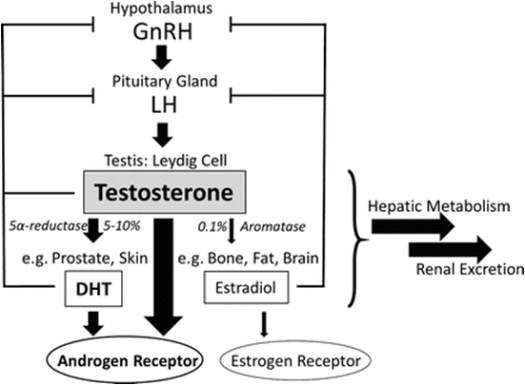
(Image source: https://link.springer.com/referenceworkentry/10.1007%2F978-3-319-44441-3_10)
Below, you will learn about seven biohacks, strategies, and protocols for optimizing the testosterone levels in your body, based on the pathways described above.
7 Little-Known Strategies To Boost Testosterone
Testosterone levels are directly related to your overall health and well-being, affecting vitality, mood, and even interpersonal relationships, considering the association with sex drive and fertility.
The first step in determining the role of testosterone in your own body is to get your levels checked.
Ben covers the options for tracking and testing male hormones in his podcast episode 32 Natural Ways To Increase Testosterone (Plus Testosterone Cream Vs. Injections). There are a number of good testing options that will give you detailed information about your testosterone levels along with other hormones, minerals, proteins, and more. The Advanced Blood Testing Panel is a comprehensive blood testing package. Ben and I also both recommend the DUTCH Urine Steroid Hormone Profile from DirectLabs, a cutting-edge way to measure hormones and hormone metabolites that can be done in five minutes (or however long it takes you to pee on the filters they send and put your samples back in the pre-paid package). Once you have determined your current hormone levels, you can decide how to proceed if testosterone needs to be raised.
In that podcast episode mentioned above, Ben also talks about a number of ways to elevate testosterone levels, and in this article, you will be presented with additional tactics and the latest research in testosterone optimization. The following seven strategies require a minimal degree of time and effort to implement and have the potential to have a significant impact on your quality of life.
1. Icing Your Testicles To Boost Testosterone & Fertility
If you’ve taken a cold shower in the past or have a regular practice of cold shower therapy, you have likely noticed improvements in general vitality, resilience, and well-being. (Check out this podcast and this article for more about cold therapy from Ben.) But did you know that applying ice/cooling the testes can help to trigger greater testosterone production and almost double your sperm count? Well, as crazy as the practice sounds, icing the testes has now become an internet hit, as there are literally thousands of men around the globe who are seeing ‘big’ (ha) benefits from icing their testes.
So why does icing the testes actually work? The bag of skin that holds and helps to protect the testicles hangs outside the body. Remember that the testicles make sperm. To do this, the temperature of the testicles needs to be cooler than the inside of the body. This is why the scrotum is located outside of the body. The testes are highly sensitive to heat, and even a marginal 2 degrees of elevated temperature in this region can arrest spermatogenesis.
When you apply an ice pack to the underwear where the testes hang—not directly to the skin, please, we don’t want to burn the skin!—this causes a major vasoconstrictive (constriction of the blood vessels) effect which then leads to a rebound vasodilatory response, rushing blood flow, oxygen, and nutrients to the Leydig cells of the testes, enhancing their ATP production and subsequent testosterone output.
What are the purported benefits of icing your testes?
- Increased libido
- Increased nocturnal penile tumescence (“morning wood”)
- Deeper voice
- More energy
- Increased testicular hang size
Here's how to ice your testicles, in three simple steps:
- Apply the ice pack to underwear where testicles hang (remember, not directly on the skin!).
- Leave the ice pack for 10-15 minutes.
- Repeat 2-3 times daily.
The most ideal time to ice is before the gym and before bed. This is because testosterone secretion peaks during these times.
You can also easily (who knew?) get a pair of testosterone-enhancing, testicle-icing underwear (with insertions for gel ice packs), which make it more convenient to ice.
Check out this video for more information about icing the testicles, and in case you're interested, also cover the practice in my course 30 Days To Higher Testosterone Masterclass (use code BENG10 for 10% off).
2. Choose Testosterone-Boosting Supplements Carefully
There are many supplements out there designed to increase testosterone levels. Unfortunately, many of them contain high doses of zinc and D-Aspartic acid.
If you are deficient in zinc, supplementing will indeed boost testosterone levels, but not if your zinc is already sufficient, and in that case, more can in fact be harmful. A low dose of zinc—15 mg per day—is adequate for most men. After 120 days, rodents on diets containing twice the RDA of zinc develop metabolic syndrome. Therefore, it is paramount that you get your zinc levels checked before blindly taking a zinc supplement in the hopes that it will magically boost your testosterone even higher.
Now I want to delve into why D-Aspartic acid is not a good idea. D-Aspartic Acid (DAA) is a naturally occurring non-essential amino acid. It is found in the protein components of foods and good dietary sources include casein, soy, and corn. It can also be made in the body from L-aspartate.
DAA saturates in neuroendocrine tissue such as the pituitary gland, pineal gland, and gonads (testes) where it works as an excitatory stimulatory compound to trigger the release of hormones. As the levels of DAA build up in these tissues, the production and release of hormones increases, and particularly LH. LH is released from the pituitary gland and it signals the release of testosterone from the testes. Once the testosterone has been released in excess, your body works to maintain homeostasis by balancing the hormonal ratios.
Negative feedback mechanisms in the pituitary gland switch off further testosterone release to drop testosterone levels and your body starts converting testosterone to estrogen via the enzyme aromata (also called estrogen synthetase or estrogen synthase). DAA supports this by increasing the aromatization of testosterone to estrogen, and testosterone levels drop while estrogen increases to normalize the ratios and maintain equilibrium. This is what makes DAA usage unpredictable. There is adequate DAA in the diet to fuel the neuroendocrine system, especially if the diet is protein-adequate. Supplementing with high doses of DAA to saturate the neuroendocrine system and trigger excessive release of hormones will create a temporary spike followed by increased negative feedback and increased conversion to estrogen to maintain hormonal balance.
Another ingredient to watch out for is mucuna pruriens. This particular herb is often added to testosterone boosters since it contains L-dopa, an immediate precursor to dopamine. Dopamine and testosterone do tend to work hand in hand; the higher your dopamine, the higher your testosterone levels. However, when these supplements use mucuna pruriens that is standardized to >15% L-dopa content, you're playing with fire. Why? Because L-dopa, being an immediate precursor to dopamine, can override the brain’s dopamine synthesis pathway, and leave you with less dopamine when supplementation stops. This can result in downregulation and a long recovery time to restore dopamine synthesis unless combined with a powerful dopaminergic restorative nootropic called Bromantane. Dopamine is significantly enhanced by Bromantane. It does this through a non-depleting manner, via enhancing the actual enzyme (tyrosine hydroxylase), which converts tyrosine into L-dopa, and subsequently dopamine. It strengthens motivation, mood, and focus, via improving overall dopamine output from the amino acid L-tyrosine found in the food we eat.
One core supplement/herb that has been shown to reliably and dramatically enhance testosterone levels is a ginseng herb called cistanche.
 Cistanche targets various aspects of performance enhancement, ranging from cognition to hormones and even longevity. As a powerful tonic, this herb outperforms any other ginseng in terms of its benefits for male performance, for example:
Cistanche targets various aspects of performance enhancement, ranging from cognition to hormones and even longevity. As a powerful tonic, this herb outperforms any other ginseng in terms of its benefits for male performance, for example:
- Cistanche extract shortened the erectile latency and prolonged the erectile duration to minimize the negative effects of castration. Basically, this means that cistanche can prolong human erection time and reduce the time taken to achieve a “full” erection.
- Cistanche increases sperm count (2.3- and 2.7-fold) and sperm motility (1.3- and 1.4-fold) and decreased the abnormal sperm (0.76- and 0.6-fold). The serum level of progesterone and testosterone in rats was also increased.
- Cistanche reverses BPA-induced abnormality in sperm characteristics, testicular structure, and normalized serum testosterone enhanced the testosterone biosynthesis. Remember that BPA is found in plastic bottles. If you’ve ever drunk from a plastic bottle before, your body is likely swimming in plastic!
Click this link to watch a video about how cistanche works.
A key molecule found within cistanche is called echinacoside. Echinacoside is demonstrated to possess many pharmacological activities, such as anti-aging, neuroprotection, enhancement of learning and memory, improvement of cardiac function, reduction of hyperlipidemia and hyperglycemia, and prevention of obesity-induced diabetes and metabolic syndrome. Other ways in which echinacoside benefits you are:
- Echinacoside increases sperm quantity by targeting the hypothalamic androgen receptor. This essentially means that compounds found within the cistanche herb can interact with a region of the brain that can govern total Testosterone levels.
- Echinacoside increases leutenizing hormones levels significantly by 1.1-fold in serum, 1.4-fold in encephalon + pituitary, and 1.2-fold in testes. Remember, luteinizing hormone is the precursor to making testosterone!
- Echinacoside significantly increases mRNA (Genetic) levels of CYP11A1, CYP17A1, HSD3β1/2, and HSD17β, and particularly HSD3β1/2, which are key enzymes responsible for active hormonal conversions.
Ben has covered the importance of testing levels of significant biomarkers in order to establish a starting point for supplementation or other biohacking practices that are intended to alter levels of hormones. When considering taking supplements for increasing testosterone, you should test for zinc levels first to avoid overdoing zinc which could in fact lead to a decrease in testosterone. Supplementing with cistanche is a safe, effective way to support your testosterone levels naturally.
3. Avoid Environmental Testosterone Threats
There are many aspects of your environment that can dramatically affect your testosterone levels.
Below is a summary of these offending factors:
- Radio frequency electromagnetic waves: Clinical studies show that RF-EMFs emitted from Wi-Fi connectivity devices damage sperm and play an important role in decreasing sperm production and motility. RF-EMWs lead to increasing sperm DNA damage.
- Tobacco smoking: A tobacco smoking habit damages the morphology of sperm. But the good news is that harm done by tobacco smoking can be reversed, once a person quits smoking.
- Teas: Since tea is often considered “healthy,” it may be surprising to learn that it can have negative effects on testosterone levels. Mint tea, green tea, lemon balm, gotu kola tea, and licorice tea all have some degree of anti-testosterone or anti-fertility effects, and if you're looking to raise your testosterone levels, we recommend avoiding those teas.
- Pesticides: Unfortunately, nowadays, insecticides and pesticides in food are standard. Research study shows that pesticides mimic estrogens hormone and alter health production of sperm cells.
- Soy foods: Isoflavone is a type of phytoestrogen which is commonly found in processed soy food, and research studies have shown that isoflavone can block DHT production, which can dramatically lower sex drive.
- Plastics: Avoid the use of plastic utensils and containers, because when plastic utensils are overheated they release xenohormones and xenohormones mimicking the estrogen hormone in the human body. Even if it is labeled as BPA-free, manufacturers may use a different type of plastic that can still exert xenoestrogenic effects.
- Sauna: Sauna usage is known to extend lifespan, improve cardiovascular fitness, and much more. However, men must be strategic and careful when they sauna. First, it is important to note that the heat from sauna can reliably lower sperm production. In fact, historically, heat exposure to the testes has been utilized as a male contraceptive tool. Further, since sauna can liberate toxins into the bloodstream, this can place nearby organs at risk of compromised function. Therefore, it is paramount that men support all of their detox pathways before using a sauna, and it may also be beneficial to don a pair of your ice pack underwear in there.
4. Glandular Therapies/Organotherapy
Glandular ingredients, which refers to the use of animal tissues to try to enhance the function of, or mimic the effect of, the corresponding human tissue, have been around for hundreds of years and many doctors have used these with great success. Glandular organs, such as the heart, aorta, and liver, have been a food source in the human diet for centuries. The consumption of glandulars is believed to provide nutritional support to the corresponding gland in the human body.
Glandulars contain nutritional peptides, enzymes, and substances believed to be hormone precursors. Although some believe that oral consumption of dried glandulars is no different than consuming any other protein-containing food, this belief appears to be based on the fact that the stomach breaks down proteins into their constituent amino acids and that there is no benefit from consuming foods containing specific peptides. However, this theory ignores the fact that some ingested protein is not broken down into its constituent amino acids.
Evidence suggests that with oral consumption of glandular extracts, a small percentage (5-10%) of their peptides are not broken down into their constituent amino acids but are available for intact absorption in the small intestine. A small amount of these absorbed peptides then circulate and some of them appear to assist the human body (especially for ill persons) in performing various anabolic and catabolic processes
This is where the use of an orchic glandular can be deployed to enhance your fertility and testosterone levels. Orchic glandular extract contains a range of nutrients such as enzymes, fatty acids, amino acids, minerals, vitamins, neurotransmitters, and growth factors, all of which come from an animal source. These nutrients contain necessary building blocks for testosterone; some people might lack the nutrients needed to begin testosterone production due to a malfunction in their metabolism. Raw orchic glandulars contain high levels of testosterone precursors and provide the necessary building blocks for hormonal synthesis. Raw orchic acts as an essential supplement for men who have suffered from testicle shrinkage or male infertility due to sexual exhaustion, abusive masturbation, or testicular injury.
Ancestral Supplements has a line of Ben-approved organ glandular supplements, including a “Male Optimization Formula” that in fact contains testicular extract. Considering the ancient practice of eating the organs from a healthy animal to strengthen and support the health of the corresponding organ of the individual—also known as “like supports like”—it stands to reason that testosterone production could benefit from testicular extract (use code BEN for 10% off Ancestral Supplements).
5. Eat The Right Foods
Nutrition is perhaps one of the most influential aspects of your hormonal status and overall health.
However, nutrition can be extremely triggering for some people due to the emotional attachment many have to certain dietary practices and protocols. So here’s a little warning…
Going vegan, full carnivore, low-fat, or being in a caloric deficit can all lower your testosterone. So now you may be wondering…what type of diet is ideal to boost testosterone?
There are five key dietary principles you should adhere to in order to naturally boost testosterone to the highest possible levels:
- Shift the main fat sources to both saturated and monounsaturated fats. Examples include coconut oil, macadamia oil, extra virgin olive oil, brazil nuts, avocados, beef, and chicken. Saturated fat food sources tend to be rich in the most critical fat-soluble vitamins for testosterone syntheses, such as vitamin K2 and vitamin A. Monounsaturated fats, such as olive oil, appear to have a strong stimulatory effect on testosterone output in men.
- Incorporate low-GI carbohydrates. Consuming lower-GI carbohydrates such as brown rice, sweet potatoes, and buckwheat can help to reduce the progression of insulin resistance. Studies have demonstrated an association between low levels of testosterone and insulin-resistant states, with a prevalence of hypogonadism of up to 50% in men with type 2 diabetes mellitus.
- Consume organ meats (liver, kidney, hearts, spleen, thymus, testes). Organ meats are abundant in many molecules, peptides, fat-soluble vitamins, and growth factors that are supportive of optimal health. For example, beef kidney is rich in selenium. Studies (both animal and human) have suggested that selenium is required for spermatogenesis, male fertility, and reproductive function, presumably because of its vital role in the modulation of antioxidant defense mechanisms, other essential biological pathways, and redox-sensitive transcription factors.
- Consume nitrate-rich veggies, such as beetroot, arugula, and spinach. Nitrate-rich foods are excellent for increasing blood flow and circulation, due to their ability to raise nitric oxide levels in your body, which can help with erection quality.
- Use a specific type of pepper known as grains of paradise (Aframomum melegueta) on meals to increase testosterone. (Ben talks more about this pepper on his podcast with nutritional biochemist Shawn Wells.)
Endotoxins are another little-known aspect of your diet that can dramatically lower your testosterone levels. Endotoxins, or lipopolysaccharides (LPS), are molecules that reside in the outer membrane of gram-negative bacteria. They consist of a lipid and a polysaccharide composed of O-antigen, with the outer core and inner core joined by a covalent bond. There are many different kinds of endotoxins, which stimulate the immune system differently. Endotoxins bind to their receptor, TLR4, and initiate an immune response. Once endotoxins are absorbed into the body, they go through the portal vein to the liver, where they stimulate the Kupffer cells—resident liver macrophages that protect the liver from bacterial infections—to initiate an inflammatory response. Elevated levels of endotoxins in the portal circulation can cause a dose-dependent systemic inflammatory response, thereby lowering your testosterone levels.
Endotoxins can significantly negatively affect your health, from chronic low-grade inflammation, joint degeneration, organ inflammation and dysfunction, brain degeneration, insulin resistance, etc. In fact, this study was titled “Endotoxin-initiated inflammation reduces testosterone production in men of reproductive age.”
Inflammation, both acute and chronic, is associated with testosterone deficiency. One potential trigger for inflammation in obese men is the passage of intestinal bacteria into circulation due to a breakdown in mucosal barrier integrity. Recently, we hypothesized that this endotoxin exposure may cause androgen deficiency in obese men. To test this hypothesis, we analyzed the relationship between serum levels of lipopolysaccharide-binding protein (LBP), an indirect measure of endotoxin exposure, against male reproductive hormones, inflammatory markers (C-reactive protein, IL-1β, IL-6, TNF-α), and adiposity in 75 men. Adiposity was positively correlated with endotoxin exposure (LBP) and inflammation (C-reactive protein, IL-6) and negatively correlated with testosterone. Furthermore, endotoxemia (LBP) was negatively correlated with serum testosterone but positively correlated with IL-6. In a second interventional study, low-dose endotoxin challenge in lean men produced a transient inflammatory response that was followed by a decline in serum testosterone, without changes in LH or FSH, providing further evidence that endotoxin-driven inflammation may result in impaired Leydig cell function.
So how do you reduce endotoxins?
- Avoid eating foods that irritate the gut, which includes foods rich in oxalates such as peanuts, rhubarb, spinach, and almonds, and foods rich in trans fats, such as biscuits, donuts, and chocolate bars.
- Consume raw carrot after meals. Dr. Ray Peat recommends raw carrots as an effective way to reduce endotoxins. The indigestible fiber present in raw carrots has the unique ability to bind to estrogen and endotoxin to carry it out of your body, absorbing bacterial waste products, fermenting matter, and then pulling them out of your system with each bowel movement.
- Enhance bile production with compounds like taurine & TUDCA (or tauroursodeoxycholic acid, a bile acid taurine conjugate that has a role as a human metabolite, an anti-inflammatory agent, a neuroprotective agent, an apoptosis inhibitor, a cardioprotective agent, and a bone density conservation agent).
- Avoid rushing meals.
- Consume B vitamins.
- Consume bone broth. Ben recommends Kettle & Fire because it's made from 100% grass-fed, pasture-grazed animals that are antibiotic- and hormone-free, and uses all organic vegetables, sea salt, and herbs. (For more from Ben on bone broth, check on this article.)
- Consume colostrum. Ben has talked extensively about why you should be taking colostrum, which benefits not only your hormones, but your immune system, athletic performance and recovery, gut health, and more. Ben personally developed Kion Colostrum, which is minimally processed and non-denatured to preserve the active nutrients and maintain the full range of beneficial proteins and peptides. It's also GMO-free, hormone-treatment-free, antibiotic-free, and BSE-free, and comes in a bioactive powder form which allows you to receive the full range of bioactive nutrients.
As you can tell by now, there is a close and complex relationship between nutrition and testosterone. In my course 30 Days To Higher Testosterone Masterclass (use code BENG10 for 10% off), I take a deeper dive into how you can tweak your diet to support the optimization of your testosterone levels.
6. Get The Right Type Of Exercise
Exercise and movement can dramatically influence your hormonal output.
For example, it is known that long duration, moderate/low-intensity exercise such as running, cycling, or rowing can affect testosterone production negatively as it requires prompt mobilization of metabolic resources.
In one study, researchers analyzed serum levels testosterone (T) and cortisol (C) levels and the muscle-wastage enzymes creatine kinase, CKMB, and LDH in 20 healthy male athletes (ages 25 to 40 years) in response to a marathon race (42.2 km). It was concluded that there was an inverse correlation observed between T and C levels, and the pattern of CK, CKMB, and LDH increase. This confirms that a marathon race causes marked physical stress, resulting in a sharp decline and disruption in testosterone levels.
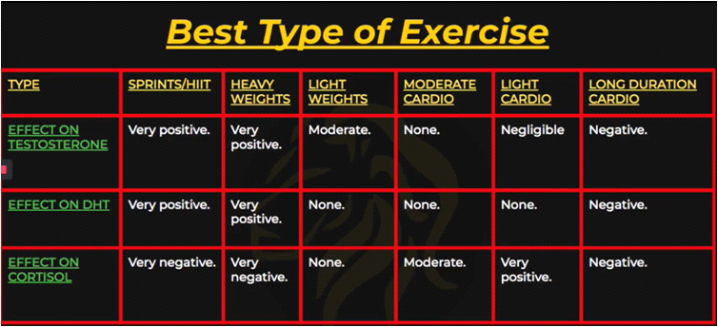
In muscle, testosterone stimulates protein synthesis (anabolic effect) and inhibits protein degradation (anti-catabolic effect); combined, these effects account for the promotion of muscle hypertrophy by testosterone.
These physiological signals from testosterone are modulated through the interaction of testosterone with the intracellular androgen receptor (AR). testosterone is important for the desired adaptations to resistance exercise and training; in fact, testosterone is considered the major promoter of muscle growth and subsequent increase in muscle strength in response to resistance training in men.
The acute endocrine response to a bout of heavy resistance exercise generally includes increased secretion of various catabolic (breakdown-related) and anabolic (growth-related) hormones including testosterone. The response of testosterone and AR to resistance exercise is largely determined by upper regulatory elements including the acute exercise program variable domains, sex, and age. In general, testosterone concentration is elevated directly following heavy resistance exercise (6-10 reps) in men. In general, the variables within the acute program variable domains must be selected such that the resistance exercise session contains high volume and metabolic demand in order to induce an acute testosterone response. If you're looking to optimize testosterone levels, aim for 3-4 weight sessions per week, 1-2 sprint/HIIT sessions, and one recovery day (low-intensity steady state).
7. Wear EMF-Blocking Underwear
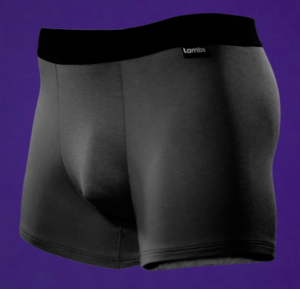 If you take your testes seriously and want them to operate at their peak, then wearing a pair of EMF-blocking underwear may help.
If you take your testes seriously and want them to operate at their peak, then wearing a pair of EMF-blocking underwear may help.
Your testes are highly sensitive to electromagnetic radiation. These EMFs can damage your testes and hurt fertility. Our beloved everyday electronic devices, such as phones and laptops, generate electromagnetic fields (EMFs) which are extremely deleterious to our health. (Though as Ben explores in this article, not all EMFs are dangerous, so it's important to educate yourself about the subject.)
Recent studies have elucidated the potential of EMFs to suppress testosterone levels and lower sperm quality. Other detrimental effects of EMFs include impaired function of the nervous system, cellular damage, and potentially cancers and tumors. EMF-blocking underwear can safeguard up to 99% of radiation, so you can rest assured that you’re shielding your sack whilst wearing these.
Summary
There you have it.
The strategies outlined above are proven tactics for upping your levels of testosterone without subjecting your nether readings to treatments with nasty side effects that could range from minor to quite severe.
I don't know about you, but that's not a game of rolling the dice that I really want to play. Rather, I encourage you to try the seven tactics Lucas outlines in this article, which, as a review, are:
-
Ice your testicles daily.
-
Choose your supplements carefully, avoiding zinc (unless you are deficient) and D-Aspartic acid, and try a ginseng herb called cistanche.
-
Avoid environmental testosterone threats such as RF-EMFs, tobacco smoking, certain teas, pesticides, soy foods, and plastics.
-
Implement glandular therapies/organotherapy.
-
Eat a testosterone-friendly diet and avoid endotoxins.
-
Exercise with heavy resistance.
-
Wear EMF-blocking underwear.
In addition, if you're looking to take your knowledge to the next level, then you may be interested in Lucas Aoun's 30 Days To Higher Testosterone Masterclass here (and use code BENG10 for 10% off), which expands on the tactics above as well as teaching you erection hacks, how to lower cortisol, and a cause of premature ejaculation you probably haven't heard of before. With modules with titles like “Perform Like A Pornstar,” it probably goes without saying that this is not your typical online course.
Whether it's a podcast or an email or an Instagram post, whenever I talk about testosterone, the response is huge (pun intended…:) and as a fellow man who places a pretty high value on my own manliness, I get it. The strategies in this article don't involve a lot of effort, expense, or time. In fact, by the end of today, you could probably ice your balls, eat a handful of Brazil nuts, and order a pair of EMF-blocking underwear. No single practice is, of course, going to bring a dramatic rise in testosterone levels, but when the tactics are layered mindfully and practiced regularly, you can move the needle without testosterone replacement therapy and the associated risks.
What do you think? Are you ready to grab a bag of ice and go at it? Seriously, though, have you tried or do you plan to try the strategies that Lucas outlined in this article? Leave your comments, questions, and thoughts below. Lucas and I will be reading and responding!



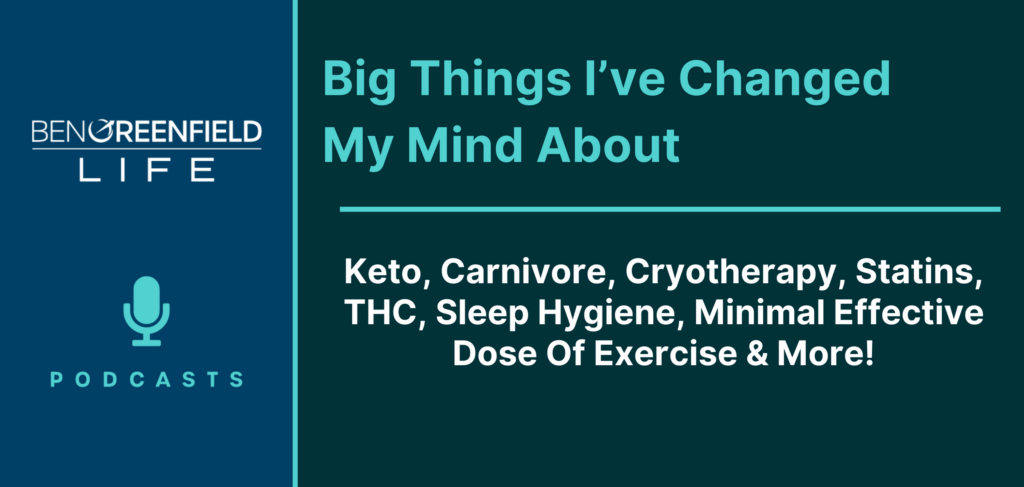
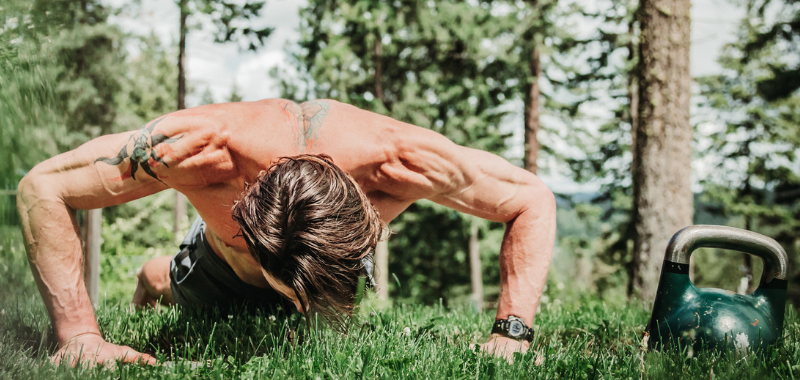




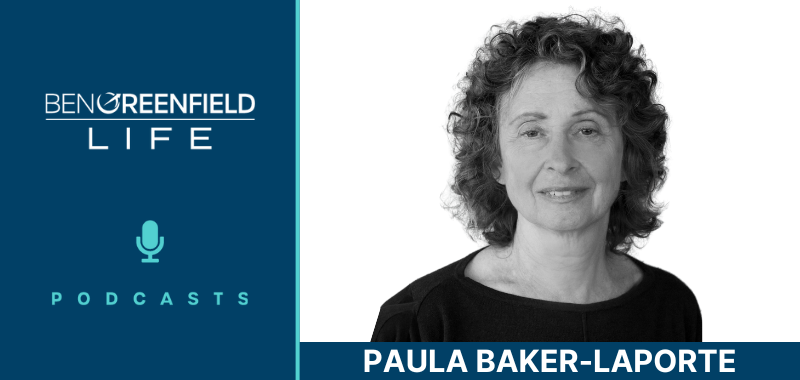




What age should a young male start icing? I have 3 sons and they all are very active; run, lift heavy objects, play sports, etc… should I have them ice their junk after a long hot run?
following up on your interview w/ Jay Campbell, hair loss solutions with his company Aseir and have to say that I am disappointed to say the least. My interest was piqued due to hair loss on what I perceive to be a very healthy individual; i.e. keto, exercise, intermittent fasting, etc.; based on your interview/endorsement – I ordered the hair loss product over a week ago and have been unable to contact Aseir directly or receive any shipping information – even though my card has been charged. I find it very suspect to not be able to contact a company directly for order, shipping, and delivery follow-up. I am concerned that this small company is all hype with no delivery — no follow-through….if a company is going to continue to charge for significant shipping fees they need to be able to deliver. I am concerned that this group of two grew too fast to be able to deliver the product appropriately or effectively and at the end of the day and that also reflects on you and your endorsement.
Hi Dawn! Thank you so much for letting me know. I have contacted the folks at Aseir and you should be hearing from them soon to resolve this issue :)
Thank you very much for the article. I’ve struggled with low T levels basically all my life. Like something wasn’t right from the get go. In more recent years tried shots (felt increase – loved exercising but brought on anxiety). Tried Clomid (still not impressed). Tried T cream but it blew up prostate. Open to your suggestions. Thanks!
Hi Todd! I'd be happy to help you via a one-on-one health consult. Just go to bengreenfieldcoaching.com/consults and choose 20, 30 or 60 minutes, whichever you prefer. I can schedule ASAP after you do that. Thanks!
If I want to continue my sauna use while trying to conceive , how far from ovulation do you recommend stopping ? days, weeks, or all together? Thanks!
great article Ben. Question, do you still use the Joove light therapy on your balls?
if so, what is your routine with light therapy and ice?
I would love to hear the benefits of doing both.
thanks for putting out great information
Thanks for reading my article Jake!
The ice routine can be found here: https://youtu.be/SadcUFe2KZ8
that’s my doubt too !!!
light + ice ??
So glad to see you guys teaming up because I’ve followed you for a long time Ben and have followed Lucas from the early days so it has been really cool to see him progress and get the respect he deserves. I see you guys at the top of the pyramid for true health ‘scholars’ we’ll call it. Or autodidacts maybe but happy to get really cool info from two health authorities. Keep up the great content from a fellow biohacking super nerd..
Thanks Vince!!
Appreciate the support. 💪🏽💪🏽
Would you suggest taking Bromantane with the Mike Mahler’s Testosterone Booster product? Also since it’s a bit difficult to get, any other nootropics I could take instead of the Bromantane?
Hey Mike!
Yes, there are range of dopaminergics that can do this:
https://www.ergogenic.health/categories/mood
Can you advise what specifically a healthy woman in peri menopause should do to prevent Testosterone loss in next few years. Thank you
Very interesting and informative. I will implement many of these and let you know the effect for a 76 year old male! Thank youi for sharing.
Thanks for reading our article! Please let us know how you feel after a few weeks of implementing 🤓💪🏽💪🏽